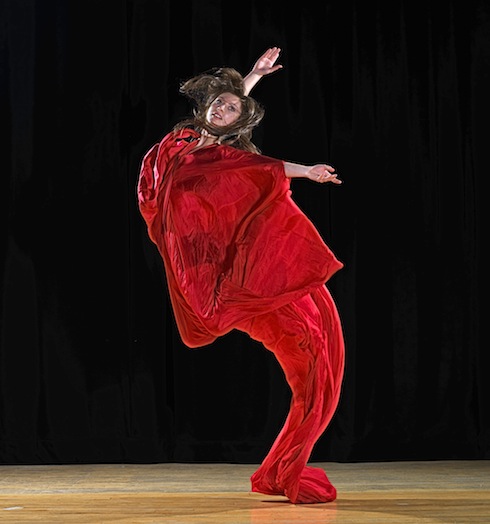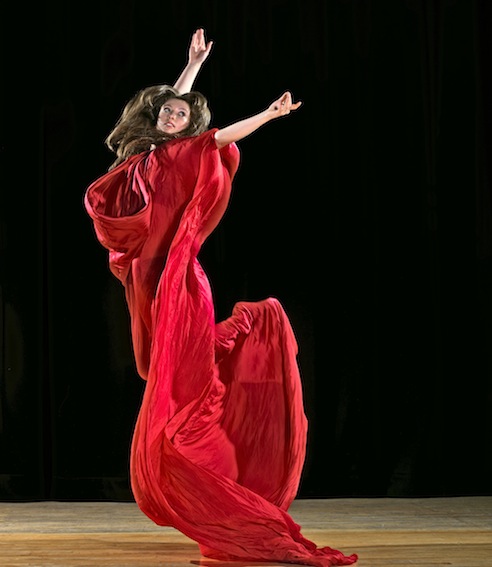The fact that Alex Roth turned his hand to a multimedia, inter-disciplinary project is hardly surprising when you discover that he is continuously involved in more than 10 different bands and musical partnerships. As a guitarist, composer, improviser, bandleader, interdisciplinary artist and creative producer, he can be found working on everything from Guitarmageddon! bringing together improvising electric guitarists, to Sefiroth, an electro-acoustic chamber ensemble playing contemporary interpretations of traditional Sephardic repertoire. Arvoles Lloran Por Lluvia brings that music together with other disciplines to help tell the stories from Kabbalist mysticism, with dance by Katarzyna Witek and film projection and interactive lighting by SDNA.
We chatted to Alex about the history behind the songs, how music is consumed today and the art of collaboration.
Run-Riot: With music, dance, film projection and interactive lighting, Arvoles Lloran por Lluvia sounds like an otherworldly experience- is this something you needed to aim for in order to convey the medieval Sephardic folklore and narrative?
Alex Roth: That was certainly a factor. The melodies and lyrics of the songs themselves carry centuries of history and their sense of drama is so strong that to me they were crying out for a theatrical, multi-layered approach to performance. The texts are intensely poetic and rich in metaphor and emotion, and often their heart-breaking intensity is offset by an exquisite melody – this counterpoint lends itself naturally to a multimedia treatment. Many of the “otherworldly” elements of the production are based on aspects of Kabbalist mysticism – a tradition whose development is interwoven with the history of the Sephardic Jews. (The band’s name Sefiroth refers to the stations of the Kabbalist Tree of Life which provide a model for understanding many different systems, ancient and modern.) Another factor in the conception of the show as an interdisciplinary piece was that I wanted to expose this repertoire (and this band) to new audiences – people who might approach it from dance, theatre or digital art perspectives and hear this kind of music for the first time.

RR: Many songs on your album have been handed down for generations but never recorded before- is this a family affair for you? Did you grow up hearing these songs?
AR: I did hear quite a lot of Jewish music growing up – both liturgical repertoire in synagogue and folk songs at home. My uncle sings in a well-known Jewish choir of which my grandmother was also a member, and my mother is a music teacher. I have fond childhood memories of hearing her improvising piano duet arrangements of klezmer tunes with my older brother Nick (who now co-directs Sefiroth with me). When we were old enough my other brother Simon (who plays percussion in the band) and I would join in! Nick later began seriously exploring eastern European Jewish repertoire – as well as Balkan and Arabic music – and I learned many of those tunes from him. However, I didn’t come across Sephardic music until much later. For me, klezmer had overshadowed other Jewish musical traditions, and I was amazed to discover another strand that sounded so different from the one I knew. In medieval Spain and Portugal, the Sephardic Jews picked up Arabic influences from the Moors, and after being exiled from the Iberian peninsula in the 15th century many travelled across the Mediterranean, North Africa and the Middle East, assimilating further cultural influences along the way, so the music has a very different character to that deriving from eastern Europe. But interestingly it shares the bitter-sweet, yearning quality one finds in much klezmer. One of the ideas behind Sefiroth was to bring this lesser-known strand of Jewish music to audiences who have perhaps listened to klezmer or flamenco or fado but have never heard beautiful Sephardic ballads like Adio Kerida. Even within this relatively overlooked tradition there are what you might call standards – a handful of songs that tend to be performed more commonly than others. Some of these have found their way into our repertoire, but we’re also interested in discovering lesser-known songs and we’ve derived most of our interpretations from transcriptions made by a friend of Nick’s (the American musicologist Joshua Horovitz).
RR: Do you think it’s important for people to go back to consuming music as a live, immersive experience rather than simply downloading tracks online?
AR: To me, part of music’s magic is that everyone can develop their own unique relationship with it over a lifetime. Listening to a piece of recorded music at home or on the move is clearly a very different experience from attending a live performance, and each fulfils a different, perfectly valid function which feeds that relationship. But generally speaking, I think many musicians are now focusing on producing more ambitious live shows to compensate for the fact that it is becoming increasingly difficult to make money solely from selling recordings. Of course, in sectors of the industry that generate the highest revenue it is more easily justifiable to splash out on lavish stage design, hi-tech visual effects and crowd-pleasing choreography. In fact I suspect fans of Lady Gaga or Beyonce would be somewhat disappointed if they were to fork out considerable sums of cash to attend a concert that lacked these ingredients. In so-called “niche” genres, which typically generate less revenue, it is seldom possible to produce live events on a comparable scale. The catch-22 is that with lower production budgets, fringe ventures cannot justify the kind of ticket prices that would enable them to forward-fund bigger and better subsequent shows. With Arvoles Lloran por Lluvia I have tried to produce a concert experience that meets current audiences’ demand for multi-sensory immersion, without the artistic compromises that I associate with productions whose primary concerns are financial. So we are working with set, costume and lighting designers, digital artists and dancers – but each collaborator is coming from a background of creating experimental work outside the mainstream of their respective discipline. I think this is the future of performance production for non-mainstream artists but clearly it can only be sustained in an economic environment with the infrastructure to support this kind of activity through public funding. I feel fortunate to be working in such an environment, even though there are worrying signs that this infrastructure may change at any moment.

RR: I read that it’s taken two years to create this production, is that true? Was that due to the time it must take to work in so many different artforms- with your band, as well as a choreographer and digital artists?
AR: I see Arvoles Lloran por Lluvia very much as an extension of Sefiroth’s previous work, so one could even trace its origins back to 2010 when Nick and I formed the band. Certainly Sefiroth’s EP of the same name (recorded in 2011 and released in 2012) was an important stepping stone on that trajectory. But I started thinking in earnest about doing something like this in 2011 so the period from conception through to realisation has been around two years. For most of that time though I’ve been juggling several other projects and working on Arvoles intermittently. Also it took over a year to get all the funding together, but I’d definitely count that as part of the process as during that time I was still refining my ideas for the production. One of the most time-consuming aspects of the production was the story-writing. It was a delicate task because it required intensive research into the history and philosophy of Jewish mysticism, and also because I wanted to weave in characters and events mentioned in the songs. I’m happy with the balance we’ve struck between these elements but I also feel that there are countless other possible interpretations of the same source material.
RR: You’ve collaborated with all sorts of fantastic musicians like Catriona Price, Kit Downes and London Sinfonietta. Who’s left on your bucket list?
AR: I’ve been very fortunate to be have worked with open-minded and creative artists across many different disciplines. Some of my favourite musicians are also close friends: people like saxophonist Joe Wright and bassist James Opstad (who both play alongside me, Nick and Simon in my band Otriad); and trumpeter Laura Jurd, vocalist Lauren Kinsella and drummer Corrie Dick (my bandmates in Blue-Eyed Hawk). Another exciting project in the pipeline is an electric guitar ensemble with Chris Montague (of Troyka) and Chris Sharkey (of TrioVD) – probably my two favourite guitarists in this country. Last year we recorded an (as yet unreleased) hour-long suite that I composed especially and I’m really looking forward to developing this in a live direction. As an improviser, there are of course many musicians I’d like to work with: Tyshawn Sorey, Evan Parker and Mederic Collingnon spring to mind (maybe all at the same time)! After this period of intense research into traditional music I’m also looking forward to getting back into composition – I’d love to be commissioned to write for new music groups such as Alarm Will Sound, Bang on a Can or Kronos Quartet. But Arvoles Lloran por Lluvia has really whetted my appetite for interdisciplinary work and I’m very interested in pursuing this further. I would love one day to work with choreographers like Hofesh Shechter or Russell Maliphant, the artist Andy Goldsworthy, designer/director Onur Senturk or writers like Gabriel Garcia Marquez or David Mitchell. Oh, and David Attenborough, but Bjork got there first!
Arvoles Lloran por Lluvia is on from 8th-10th October, tickets here.
